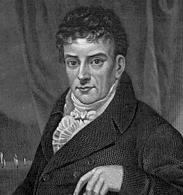Robert Fulton was an American artist, engineer, and inventor. He is best known for innovating commercial steamship travel, which helped spur the American Industrial Revolution.
Fulton’s Life
Fulton was born on a Pennsylvania farm in 1765. He worked as an artist before traveling to Europe at the age of 23. While first gaining commissions to paint portraits and landscapes, Fulton soon became interested in mechanical engineering. He patented several inventions related to canals and boats. His Treatise on the Improvement of Canal Navigation contained detailed plans for building canals and bridges, as well as novel ideas to raise boats using planes rather than locks.
In 1804, Fulton tested the first successful submarine, which was named the Nautilus. The submarine was designed to travel underneath warships and plant a powder charge, which would explode later. Although the Nautilus was operational during the war between France and Britain, it never launched a successful attack.
Fulton was also extremely interested in steam power, which was being explored by others as a means to propel ships. In the early 1800s, Fulton met Robert R. Livingston, who was serving as the U.S. Ambassador to France. The two men decided to team up to launch a commercial steamship operation back in America. Livingston had already obtained an exclusive license for steamboat navigation on the Hudson River in New York.
By the time he returned to the United States, Fulton had gained fame as an inventor. In 1807, Fulton’s North River Steamboat of Clermont traveled the 150 miles from New York City to Albany in 32 hours. The trip was revolutionary given that it took sail-propelled sloops four days to complete the same journey.
After the successful trial, the Clermont entered into commercial service, carrying passengers and light freight. Fulton and Livingston expanded their business to river crossings in New Jersey, Boston, and Philadelphia. During the War of 1812, Fulton built the first steam warship to defend New York Harbor.
In 1812, Fulton and Livingston built a new steamboat, the New Orleans. As the name suggests, the ship was designed to travel from Pittsburg to New Orleans, via the Ohio and Mississippi Rivers. The ability of the steamboat to go both up and down river helped foster settlement of the newly acquired Louisiana Territory.
While Fulton was very successful, he spent most of his fortune defending his steamship monopoly from competitors, as well as developing and patenting new inventions. He died at the age of 49, after going into the icy Hudson River to rescue a friend.









